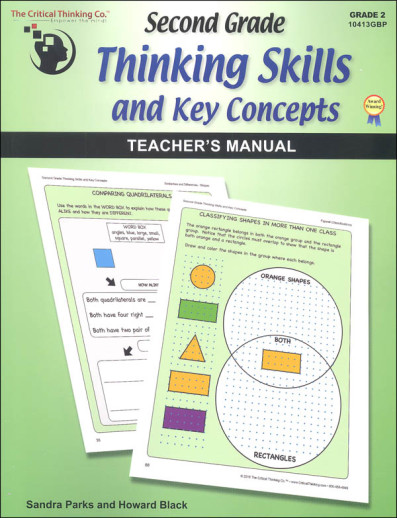We use cookies to make your experience better. To comply with the new e-Privacy directive, we need to ask for your consent to set the cookies. Learn more.
Second Grade Thinking Skills & Key Concepts Teacher's Manual
This Teacher's Manual provides instructions to teach the lessons using research-proven methods that promote students' thinking: direct instruction, cooperative learning, whole sentence responding, and language integration activities. The Teacher's Manual physical book is in black and white.
With the current trend in critical thinking/thinking skills as it relates to cross-curricular studies, why not rely on the publisher who has provided quality material on this subject for years? A new series from Critical Thinking Co, this program actually seems like an expansion of the popular Building Thinking Skills program. Incorporating all its excellent conceptual development and expanding beyond mathematics into science and social study applications, this series takes students beyond state and Common Core standards. Designed to be a discussion-based curriculum, teacher-student interaction is vitally important and, in fact, the publishers warn against trying to do the program by handing your student a workbook page. Program goals include clarifying and practicing various thinking skills (describe, compare/contrast, sequencing, classification), developing the academic vocabulary needed to describe key concepts in mathematics, science, and social studies, and to promote clear conceptualization of key concepts even in the primary grades knowing these will become more complex in later grades. You can expect lessons to take 20-30 minutes.
Bright and colorful, the Student Books are consumable. Instructional methods include teaching skills explicitly, using different learning styles for some teaching, responding in whole sentences, and applying the concept in new forms. For example, in the Kindergarten book, twelve chapters cover describing (colors and shapes), similarities and differences, sequencing (shapes), classifying and sorting (shapes): then applying these skills to various categories (i.e. family members, food, animals, jobs, vehicles, and buildings). Lastly, position is covered in both thinking and writing. We can begin to get an idea of the progression of the series when we look at the scope of the First Grade course. Shapes are used to cover descriptions, position, similarities/differences, sequences, and groups. Then, there is the same progression through various categories but using the same sorts of concepts with shapes: classification, comparing, describing, similarities/differences, etc. Lots of color photos of real people, places, and things are used within the lessons.
Teacher Manuals include instructional and conceptual information for every worktext page. This material is lightly scripted and leads the teacher through the introduction, stating the objective as well as conducting the lesson. A greatly reduced, black and white copy of each student page supplies the answers. In addition, there is general introductory information on the course as well as introductory information for each chapter. As mentioned earlier, the obvious intention of the Teachers Manual is to facilitate discussion through the material and to make it easy on the teacher to provide that discussion. Teacher prep for the lessons is minimal but teacher-student interaction is expected and required. This series appears to be an excellent choice if you desire to make sure your student is prepared for higher order thinking in upper grades and for standardized testing that is based on Common Core. I do have one small quibble that I hope is addressed in future printings. It is very difficult to distinguish the royal blue color from the purple color. You can do it if theyre side by side but if only one color is present on a page, you may find yourself a bit unsure (I know I was). Student books 154 pgs, pb. Teacher Manuals 212 pgs, pb. ~ Janice
| Product Format: | Paperback |
|---|---|
| Brand: | Critical Thinking Company |
| Grade: | 2 |
| ISBN: | 9781601448453 |
| Length in Inches: | 11 |
| Width in Inches: | 8.5 |
| Height in Inches: | 0.5 |
| Weight in Pounds: | 1.4 |

